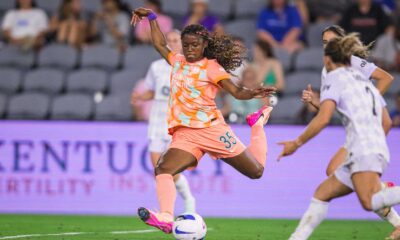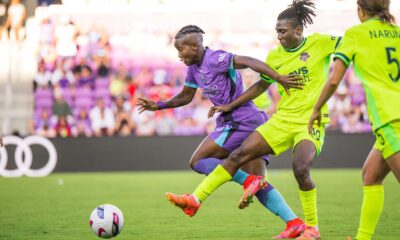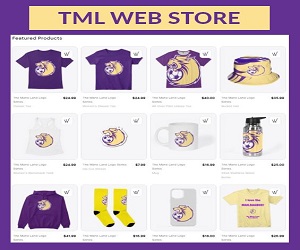Orlando Pride
How Orlando Pride Players Have Performed in Olympics Past and Present and Predictions for the Future
A deep dive into the history of the Orlando Pride at the Summer Olympics.
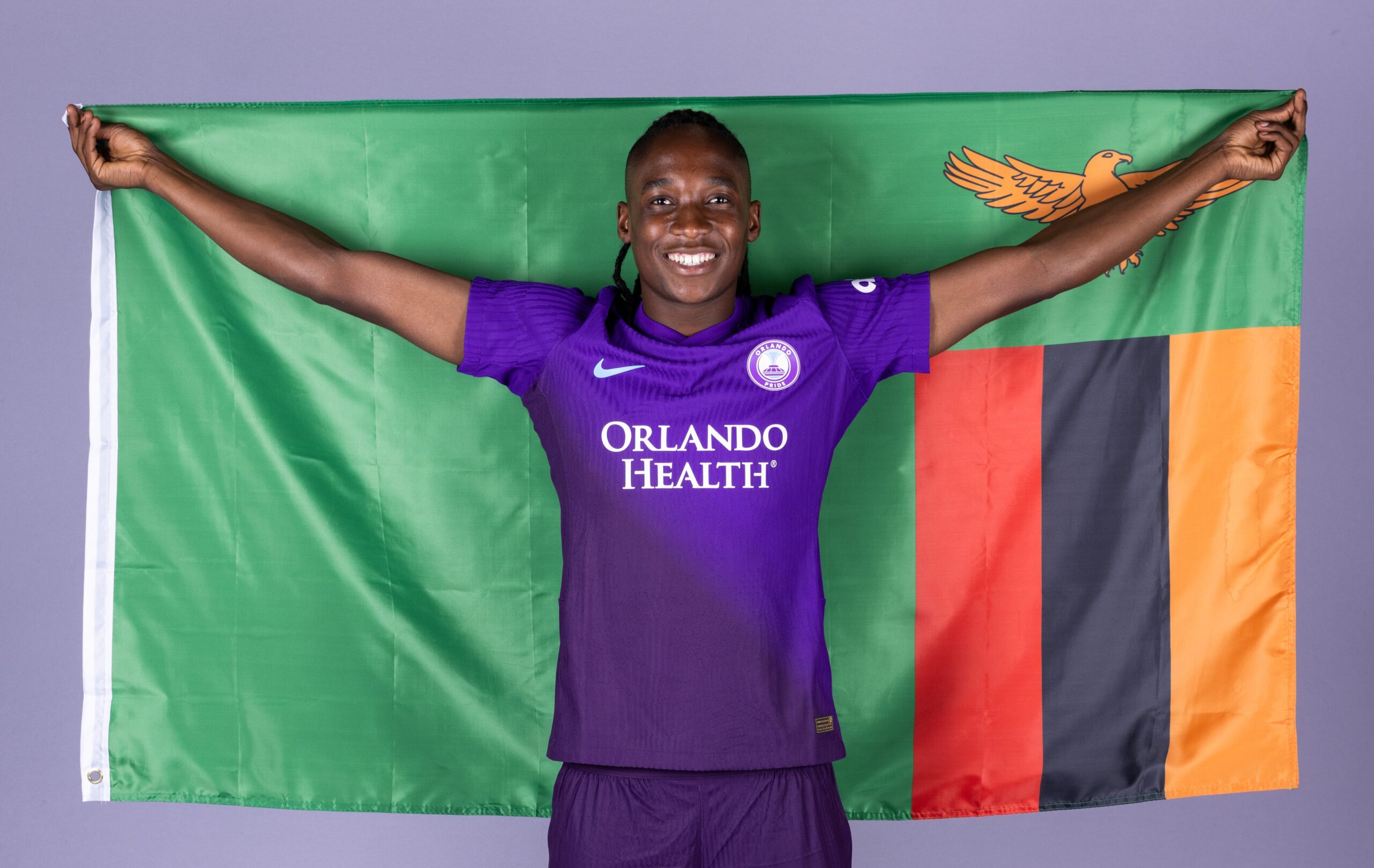
Charles Dickens I am not, but being that much of the women’s soccer world is focused on the Olympic football (soccer) tournament, I want to write a little about the (ghosts of) Orlando Pride’s Olympics past, present, and future. The good news is that we are going to be looking at the fun topic of players who played, or still play, for the Pride. The bad news is, again, you will be reading my prose and not that of Charles Dickens.
It would take some real David Copperfield (you English majors out there see what I did there) type magic for Dickens to write this since he died in 1870, 26 years before the first-ever Summer Olympics and 126 years before the inclusion of women’s soccer in the 1996 Olympic Games in Atlanta. We will not be going all the way back to 1996, but let’s go back to 2016 and 2021 (and yet, somehow, also 2020), and from there we will look at the current Paris games and I will close with a prediction about which Pride players I think have a chance to participate in a future Olympiad.
The Pride’s inaugural season was 2016, and that team sent five players to the Rio de Janeiro Olympics: Steph Catley and Laura Alleway represented Australia; Mônica represented Brazil; Josée Bélanger represented Canada; and the face of the franchise, Alex Morgan, represented the U.S. All four nations advanced out of the group stage and into the knockout stage, and all of the Pride players averaged playing at least 60 minutes per match, with two players even averaging more than 90 minutes per match due to playing in games where there was extra time.
Here is a chart of some of the 2016 Pride players’ key statistics during those Olympic games, laid next to their stats from the NWSL season (all data from fbref.com, and it should be noted that Alleway, Catley, and Mônica were defenders):
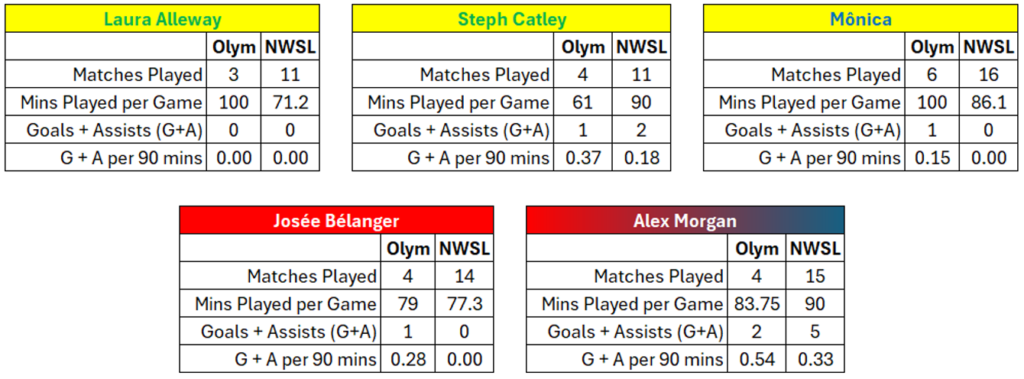
A few items on these players and their performances in the 2016 Olympics:
- There were several Pride vs. Pride matchups, with only Morgan going through the tournament without seeing one of her teammates on the opposing side of the field.
- Canada defeated Brazil in the third-place game, with both Bélanger and Mônica going the full 90 for their respective teams. Also on the field during that match for Brazil were future Pride players Marta and Rafaelle, though neither were playing in the NWSL at the time.
- Morgan’s two goals tied her for sixth in the Olympics, despite the Yanks’ early departure in the quarterfinals, when they were defeated by Sweden.
- It is rather crazy to see that both Alleway and Mônica averaged more than 90 minutes per game, but Brazil went into extra time in two separate matches and Australia did in one.
The next Olympics should have been during the 2020 season, but despite the branding staying as the 2020 Summer Olympics, the games actually took place in 2021 in Japan due the pandemic. The Pride sent four players to Japan: Marta represented Brazil; Erin McLeod represented Canada; Ali Riley represented New Zealand; and Morgan once again represented the United States.
New Zealand did not make it out of the group stage, but the other three nations did, with Brazil losing in the quarterfinals, the U.S. winning bronze, and Canada winning the gold medal. It was somewhat of a backwards performance for the Pride players, as the best two individual performers (Marta, Riley) had their teams go out the earliest, and of the two who earned medals, one did not play at all (McLeod, who was a backup goalkeeper) and the other had a poor performance by her high standards (Morgan).
Here is a chart of some of the 2021 Pride players’ key statistics during those Olympic games laid next to their stats from the NWSL season (note: McLeod was an unused goalkeeper in the Olympics and Riley is a defender):
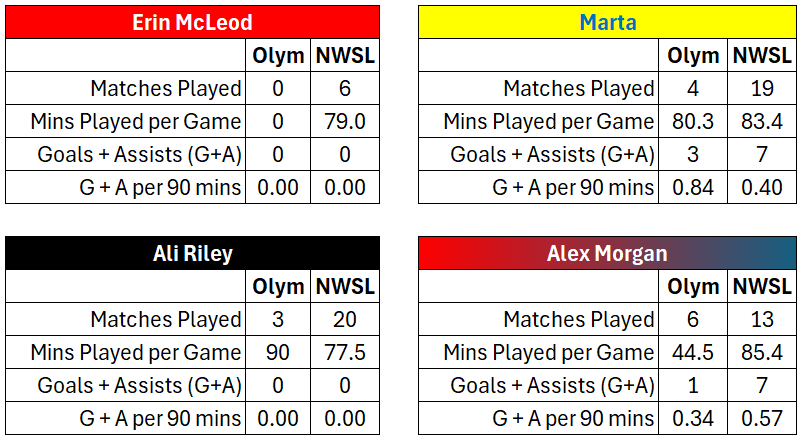
A few items on these players and their performances in the “2020” Olympics held in 2021:
- There were once again several Pride vs. Pride matchups, and this time every Pride player played at least one game against a teammate. Well, McLeod did not play, but you know what I meant. You did. I know you did.
- Both Marta and Riley were the captains for their respective nations, though neither captained even one match throughout the entire 2021 Pride season (Ashlyn Harris captained most matches, with Ali Krieger and Toni Pressley captaining the other matches).
- Marta’s three goals tied her for eighth overall, and when she scored her first goal it marked the fifth — let me repeat the fifth — straight Olympics where she had scored at least one goal. Ranking second overall in goals scored during that Olympics? A 19-year-old Barbra Banda, then playing her club soccer in the Chinese Women’s Super League.
This brings us to the current Olympiad, in which the Pride are tied with Gotham FC for the highest representation across the NWSL with seven players on Olympic rosters: Adriana, Angelina, Marta and Rafaelle representing Brazil; Emily Sams representing the U.S.; and Banda and Grace Chanda representing Zambia.
The tournament is still ongoing, so these stats may change, but here is how the players have been doing thus far, as compared to their NWSL stats (Angelina is an alternate for Brazil and was in the lineup for only one match, and Sams is an alternate for the USA and was in the lineup for only one match. Chanda was only recently signed by the Pride, so she has not yet dressed for a Pride match.):

A few items on these players and their performances in the 2024 Olympics:
- Thus far, there have not been any Pride vs. Pride matchups. Although the U.S. played Zambia, Sams was not in the lineup for that match.
- Banda scored her third career Olympic hat trick in Zambia’s matchup against Australia, which makes her the only woman ever with three hat tricks in the Olympics. She now has scored 10 goals total in her Olympic career, which ranks her tied for fourth all-time on the Olympic scoring list.
- Marta is playing in her sixth straight Olympics. Very few athletes in any sport are able to compete in six consecutive Olympics, and those who do generally play in sports which require less physical exertion than that is required from soccer (shooting, equestrian and sailing have the most athletes who have six or more Olympic appearances) .
- Both Rafaelle and Chanda suffered injuries and missed games during the group stage.
- Banda and Marta both captained their teams in every game they played.
- Brazil and the U.S. have both advanced to the quarterfinals, while Zambia is out, so the stats for Banda and Chanda are final, but the stats for the other five Pride players could change.
I would be remiss not to mention that Marta has said she will be retiring from playing for Brazil after this season, but I certainly hope that she plays at least one more match for the Seleção (Brazil’s nickname for their national team), so that her final match for her country does not end with her having received a straight red card, which is currently the case after Brazil’s match against Spain on Wednesday. Marta will be suspended for the quarterfinal match, but if Brazil wins, I am sure she will be back in the lineup for the semifinal.
That said, let’s transition to looking at the future and consider which current Pride players are most likely to make an appearance in a future Olympiad. Looking at this by nation:
Argentina — Mariana Larroquette started all three matches during the 2023 World Cup and is still a common call-up for the national team. Argentina has a decent chance to qualify for an Olympics, though it did not this year, but Larroquette may need to be playing more minutes to still be a viable selection in four years, and minutes are going to be hard to come by for the Pride as long as Banda is still on the team. My confidence level (on a scale of 1-10, where 10 is the highest level of confidence): 2.
Brazil — Luana, Marta, and Rafaelle will be likely nearing the end of their careers or possibly already retired in four years (and Luana’s soccer future is currently uncertain), so although I would never put anything past any professional athlete, I am going to remove all three from consideration. That leaves Adriana and Angelina from the Brazilian contingent, and I think it is likely Brazil will qualify and that both have excellent chances of being on that team in four years. My confidence levels: Adriana 7, Angelina 9.
Canada — Amanda Allen has already been called up to the senior team once and has played frequently for the youth national teams of Canada, one of the strongest teams in the world. Canada is likely to make every Olympic tournament until other nations in Concacaf get stronger, and since Allen is only 19, she likely has several chances to make the team at least once. She will have the same issue as Larroquette in terms of earning minutes while on the Pride, but I think her talent will get her on the field somewhere, and she will make a future Canadian Olympic Team. My confidence level: 9.
England — Anna Moorhouse was called into camp for England just a few weeks ago on the strength of a solid performance in the first few months of this season. England is very deep in goalkeeping talent though, with three players around her age or younger with eight or more starts for England and several others who are starters in the Women’s Super League in their home country. England also did not qualify for this year’s Olympics, and is in a difficult area of the world to feel confident that it will qualify in the next cycle. My confidence level: 1.
Spain — Celia has not played for the national team since 2019, and being that Spain is the reigning World Cup champion, it feels unlikely she will return to the team in the near future, let alone in four years’ time. My confidence level: 1.
Sweden — Evelina Duljan is in a similar situation to Allen, though at a different position and at a slightly older age. Duljan has played quite a few matches for the youth national teams of Sweden and seems a likely part of the senior team’s future, but she will need to get minutes at the club level in the next few years. As fellow Mane Land writer Sean Rollins wrote recently, the NWSL x Liga MX Femenil Summer Cup (which should be sponsored by Dos Equis…think about it), is a great opportunity to get some minutes for players like Duljan, who have been on the bench for most of the season. Sweden did not qualify for the 2024 Olympics and is in the tough European region, so that does knock down my confidence level for Duljan, but she is still young enough that I think she will have multiple chances in her future. My confidence level: 5.
United States — Americans make up approximately half of all members of the Pride, but I think really only a few have a chance to play for the national team: Ally Lemos, Emily Sams, and Summer Yates. Although Yates has played for the youth national team in the past and is having an excellent second season in the NWSL, I think she is a longshot to get a call-up and to be on the the team for the next Olympics, even though I have been impressed by her play this season. Lemos has been part of the youth national team since she was 14 and frequently starts for the U-20 team. She is one of only 37 players in NWSL history to have played more than 250 minutes in a season at the age of 20 or younger. I think she has a decent chance to be called up the senior national team, and then she will have a chance to prove herself and earn a full-time role. Sams is already on the team today as an alternate (recently moved to the active roster as a replacement for the injured Tierna Davidson) and will definitely be involved in the program during the next few years. My confidence levels: Lemos 5, Sams 8, Yates 2.
Zambia — Without Banda, it is doubtful that Zambia makes the Olympics, so as she goes, they go. She is one of the best players in the world, and I think she can get the team into the Olympics on her own at least once, if not multiple times during the rest of her career. Chanda I have not seen enough from yet, but she made the team and played in this Olympics and is still young enough (27) that she likely would be in contention if Zambia qualifies for 2028 and possibly also 2032. My confidence levels: Banda 10, Chanda 6.
So, there it is. I am not Jacob Marley, but we were visited by the ghosts of Pride Olympic past, present, and future, and hopefully for all of you it was as enjoyable a read as are the sounds of the music of another famous Marley — Bob, who obviously would have been a Pride fan. All the remaining Pride players will play again on Saturday in the Olympic quarterfinals, and the bracket is set up for a possible Brazil vs. U.S. gold medal game if each team can win two more games.
I will be rooting for that final, as even though it would delay the return of five players, it would be amazing to see Marta potentially close out her international career with a gold medal. No matter what, it will be exciting to see, and I look forward to watching this coming weekend.
Orlando Pride
Orlando Pride vs. Racing Louisville: Final Score 2-0 as Pride Still Can’t Win in Kentucky
The Pride lacked quality but not effort in a frustrating 2-0 road loss at Louisville.
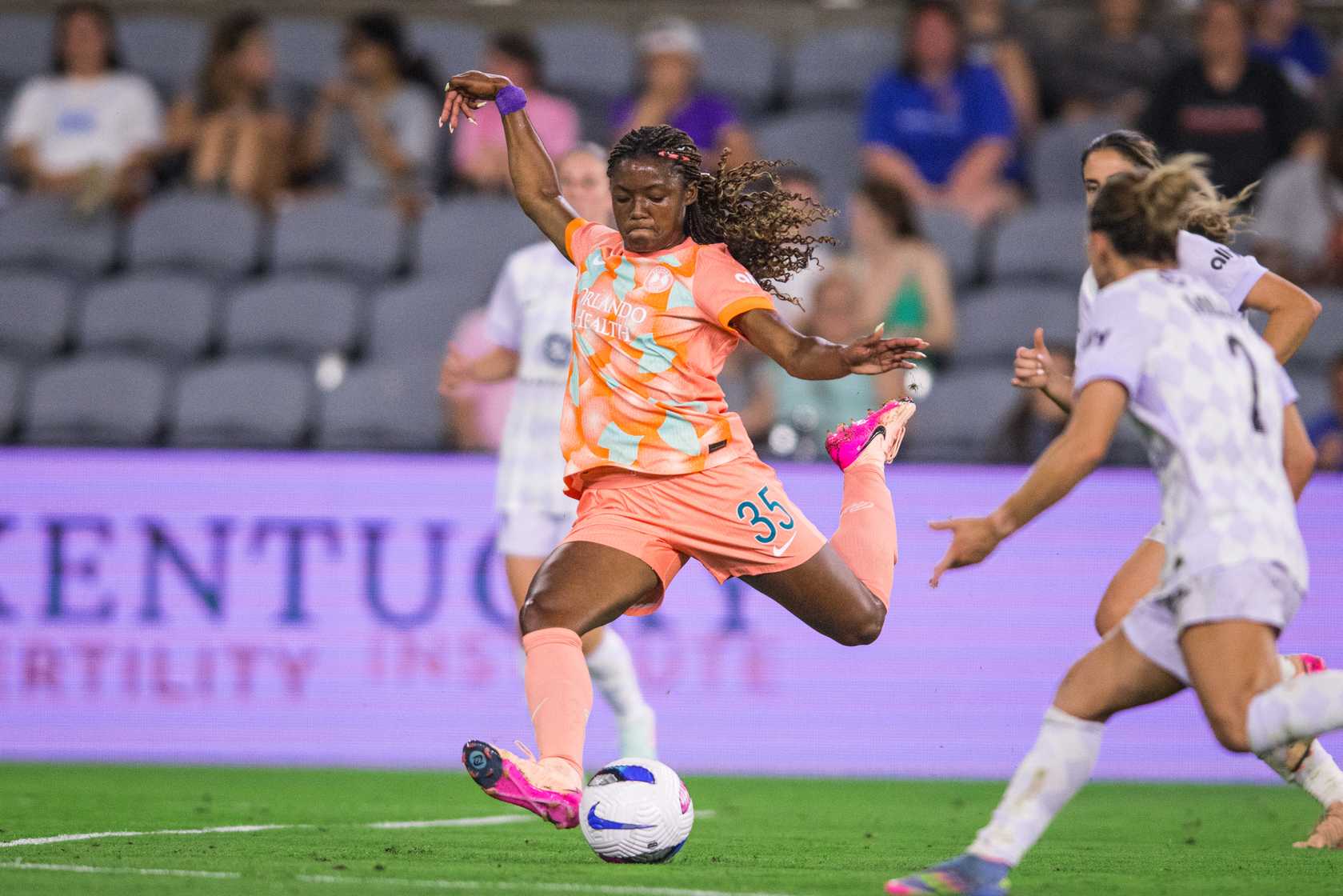
The Orlando Pride were looking to end the first half of the season on a high note, but ended up doing just the opposite in a forgettable performance at Lynn Family Stadium in Louisville. Orlando (8-4-1, 25 points) continued to waste scoring opportunities, but instead of playing the stalwart defense of the last couple of games, the Pride also failed to mark at the back post on a set piece and conceded an unnecessary penalty to gift the hosts a two-goal advantage in a 2-0 loss to Racing Louisville (6-5-2, 20 points).
Center back Arin Wright scored her first goal of the season and Taylor Flint added a penalty kick goal for Racing. The Pride dropped to 0-4-1 at Louisville since the series began and fell eight points adrift of first-place Kansas City, although the focus for now should perhaps be on finding their offense rather than catching the Current.
“Obviously disappointed with the result,” Orlando Pride Head Coach Seb Hines said after the match. “It’s come down to two set pieces.”
Hines’ starting lineup included goalkeeper Anna Moorhouse behind a back line of Cori Dyke, Kylie Nadaner, Emily Sams, and Ohihane. Haley McCutcheon and Angelina were the central midfielders with Summer Yates and Ally Watt outside and Marta and Barbra Banda up top.
Louisville came out pressing high and pinning Orlando back in its own end. The Pride eventually settled into the game, worked hard and seized the advantage in terms of possession and chances. However, they were wasteful with their few clear-cut opportunities, and rather than build an early lead, Orlando ended up gifting Racing an early advantage and had to play catch-up — something the Pride simply couldn’t do on this night.
Marta was called for an early foul that she knew little about, jumping up between two defenders. Ary Borges backed into her space, and there was contact, with Marta getting saddled with the foul. Sarah Weber got her head to the cross on the free kick, sending it just inches over the crossbar and onto the roof of the net in the fourth minute.
Orlando’s first shot came in the seventh minute after the Pride broke Racing’s pressure. The ball found Banda, who cut inside from left to right and fired from the top of the box. The Zambian international left her shot too close to goalkeeper Jordyn Bloomer, who got down and made the save.
The Pride suffered a blow moments later as Oihane went down without contact trying to keep a ball in play at the sideline. She was clearly in a lot of pain and had to be subbed off. While waiting for the sub, the game played on with Orlando using just 10 players.
Racing kept the pressure on and that resulted in shots from distance as the Pride left too much space just outside the area. Taylor Flint had a go from 30 yards out but sent her rising effort over the bar in the 11th minute. A minute later, Savannah DeMelo sent a shot from the top of the area over the goal.
Hines was finally able to send Kerry Abello on in the 13th minute, slotting her in on the left and moving Dyke to right back.
McCutcheon’s foul near the left corner of the box just past the quarter-hour mark gave Louisville a dangerous set piece shortly after the substitutions. DeMelo fired the free kick on target, and Moorhouse caught it and then got bundled over by Ary Borges who was pressed from behind by Sams.
Orlando started to settle into the game a bit after that, but did not execute well in the attack. Banda allowed Ellie Jean to knock the ball away from her in the box in the 17th minute. Moments later, Marta’s set piece delivery into the box from near the right corner of the penalty area was too low and easily cleared.
The Pride started winning corners but took all of them short, possibly to avoid Racing’s height, but they created nothing with the opportunities except a few long-range shots. On the first, Yates was knocked down in the box in the 23rd minute after getting to the end line, but the referee ruled it was a fair challenge.
Orlando should have scored in the 28th minute. Watt put in a fantastic cross to a wide-open Yates at the back post. With plenty of open net to shoot at, Yates pushed her free header wide of the left post, wasting a sitter.
“I mean, goals change games,” Hines said. “We had a chance just before their set piece (goal) where the ball gets to Ally (Watt), she takes on Courtney Petersen, puts in a really good cross. And (Yates) gets her head on it, but it wasn’t on target. And I think if that had gone in, it might have changed the trajectory of the game. You know, you’re then asking Louisville to be even more aggressive. There’s more space for us to manipulate.”
A minute later, the game turned in Louisville’s favor. Banda was too indecisive after receiving the ball in the attacking third. Leaving the ball at her feet and trying to head fake, Racing easily dispossessed the forward and broke in transition, winning a corner at the other end. Louisville paid off the set piece when Orlando left two players completely unmarked at the back post. Unlike Yates earlier, Wright got her head on the ball and didn’t miss the net, putting the hosts up 1-0 in the 30th minute. Former Pride fullback Courtney Petersen got the assist for her delivery.
Angelina fired from outside the box on a couple of short corners but the first, which may have been a back-post pass to Nadaner, went wide and out of play in the 34th minute.
Orlando again should have scored in the 35th minute. Watt did well to steal the ball in the attacking third and immediately played it to Banda. The goalkeeper was caught out, but Banda was deliberate in lining up her shot. Once she did, she missed the net entirely.
Watt had a chance to cross into the box in the 38th minute but sent her service right at Bloomer. Angelina fired a good effort from distance in the 40th minute. The dipping shot was on target but Bloomer was able to knock it out for a corner. Orlando played it short again and Angelina fired from distance only to see it deflect out off a defender. The Brazilian then ended up with yet another shot from range on the next corner, but sent it right at Bloomer.
Banda had a chance to play Marta in alone in the first minute of stoppage time, but she didn’t get enough on the pass. Flint was able to close down andknock it out for another corner. Nothing came of that one either, and moments later the half was over with the Pride staring up at a 1-0 deficit in a game they probably should have led.
The Pride finished the first half with the advantage in possession (57%-43%), shots (9-7), shots on target (4-2), corners (6-1), and passing accuracy (82%-79%). But the wasted opportunities and moment of inattentive set piece defending had the hosts out front at the break.
Hines made his second change at the half, sending Carson Pickett on for Yates. After the match, Hines said Yates hadn’t been feeling well and needed to come off, so she became the second unexpected substitution of the match.
“It kind of disrupted the momentum that we had in the first half going into the second half,” Hines said of sacrificing Oihane and Yates. “But we have good players who can adapt, and so I thought we still put them under pressure going to the second half, playing through the press.”
Louisville started the second half much like the first — as the aggressor. Emma Sears blasted wide just after the restart. On the ensuing goal kick, Orlando quickly turned it over and Borges ended up in alone on goal with the ball. With just Moorhouse to beat, the Brazilian smashed the ball off the right post, wasting an opportunity to make it 2-0 in the 49th minute.
Orlando’s first attack of the second half came in the 50th minute and it quickly broke down. Banda tried to find Pickett as she approached the box, but she made a mess of the pass and the defense cleared. The ball went to Marta at the top of the area, and the Pride captain saw her shot blocked. The rebound found Banda, who send a soft shot straight at Bloomer.
“I just think at this moment in time, everyone’s kind of adapted to us,” Hines said. “We’re getting into really good, promising positions, and we just need to execute in that last final part.”
Wright did well to keep a cross from reaching McCutcheon at the back post in the 53rd minute. Both players needed treatment after a clash of heads and were off the pitch for a few minutes.
Sears nearly made it 2-0 in the 61st minute, losing Dyke in the corner, cutting inside and must missing the far post by about a yard.
Louisville put the game away a few minutes later. On a routine throw-in, Sams was positioned well behind Weber just inside the box near the right sideline. Rather than hold her position, she tried to muscle her way around the Louisville forward, pulling her down. The referee pointed to the spot immediately.
Former Pride midfielder Flint took the spot kick. Moorhouse guessed correctly, but Flint placed the shot well to make it 2-0 in the 68th minute.
Shortly after the second goal, Hines pulled Marta, McCutcheon, and Dyke, subbing on Morgan Gautrat, Ally Lemos, and Simone Jackson, who made her NWSL debut. Those three were not likely to provide the missing piece of the attack, and they didn’t, as Orlando continued to struggle in the offensive third.
Banda put a shot on frame from a tight angle on the right in the 78th minute, but it was a comfortable save for Bloomer. The ball fell in the box near the end line where Wright was prone. Banda ran in to try to win it, but Wright wisely knocked it out off the Zambian for a goal kick.
Weber nearly made it 3-0 on another Louisville corner kick opportunity in the 80th minute. This one was slightly more contested than Wright’s and Weber put her shot wide.
Down the stretch, Orlando wasted a couple more short corners and simply couldn’t find any lethality. Banda missed the net four times in the game’s final minutes on what was an apparently frustrating night for the Golden Boot contender.
Orlando’s statistical advantage was not reflective of the final score. The Pride finished with the edge in possession (64%-36%), shots (16-14), shots on target (7-3), corners (11-3), and passing accuracy (82%-74%).
“I learned that nothing’s given, no matter what rank you are as a team,” Jackson said after making her pro debut. “So, it’s like everyone is coming after you. You have a target on your back when you wear this badge. So, I think it was wake-up call for a lot of us, and I think that I’m excited for the second half of this season.”
The Pride have a long break to stew in this performance, as the NWSL schedule won’t resume for several weeks. Orlando’s next NWSL is Aug. 3, when the Utah Royals visit Inter&Co Stadium.
Orlando Pride
Orlando Pride vs. Racing Louisville FC: Preview, How to Watch, TV Info, Live Stream, Lineups, Match Thread, and More
The Pride head to Louisville to wrap up the first half of the NWSL season ahead of the summer break.
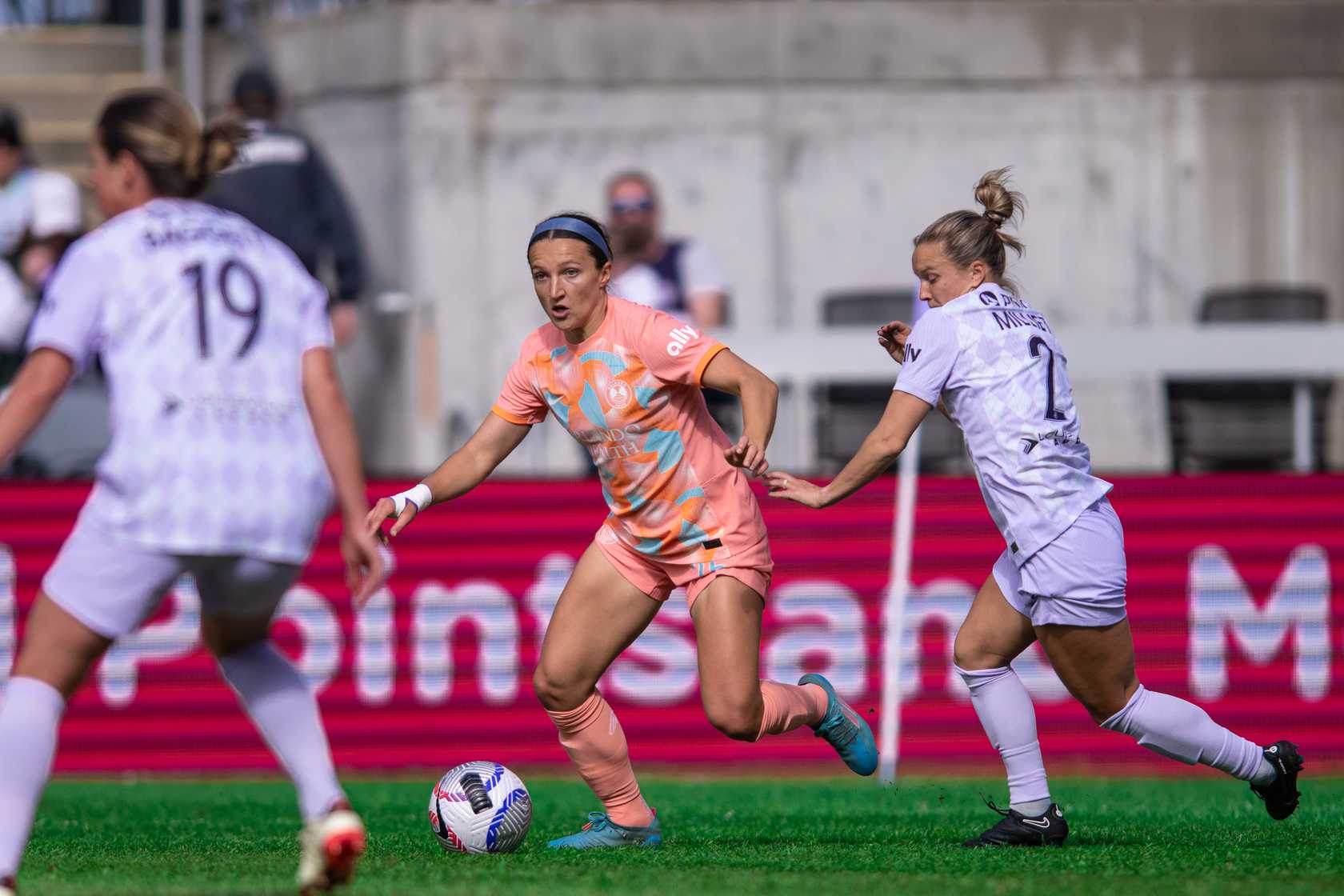
Welcome to your match preview as the Orlando Pride (8-3-1, 25 points) end the first half of the 2025 NWSL season against Racing Louisville (5-5-2, 17 points) in Kentucky. This is the first of two meetings with the second scheduled for Aug. 9 in Orlando.
Here’s everything you need to know about tonight’s game.
History
This is the fifth season of existence for Racing Louisville. The two teams have played 11 times so far, with the Pride going 3-3-5 (3-3-3 in NWSL games, 0-0-1 in the NWSL Challenge Cup, and 0-0-1 in the NWSL x Liga MX Fememil Summer Cup). The Pride are 0-3-1 against Louisville on the road in league play.
The most recent meeting between the two teams occurred in the Summer Cup last year on Aug. 1, 2024. Evelina Duljan scored her lone Pride goal in the 38th minute to give the Pride the lead. However, Reilyn Turner equalized in the 67th minute, sending the game into penalties. The Pride took the early shootout lead when Jaelin Howell missed, but saves by Jordyn Bloomer on Morgan Gautrat and Ally Watt saw Louisville take the extra point.
On May 5, 2024, in Orlando, an Emily Sams cross in the 17th minute found the head of Barbra Banda at the back post for the game’s only goal in a 1-0 Pride win. The first game of the 2024 season was on March 16 in Louisville, the season opener for both teams. It looked like it would be a long day as Elexa Bahr and Uchenna Kanu gave the hosts a 2-0 lead inside 20 minutes. The Pride got on the board in the 24th minute with an own goal by Elli Pikkujämsä, but the task was made more difficult when Kylie Strom received her second yellow card in the second half. However, Amanda Allen and Summer Yates combined on a late goal by Yates, as the Pride pulled out an unlikely 2-2 draw.
The first game of 2023 occurred on May 6 at Exploria Stadium. Messiah Bright gave the Pride an early lead and the hosts held on for 69 minutes for the 1-0 win. It was the first home win of 2023 for the Pride and their second win of the season. The second meeting was on Oct. 6, 2023 in Louisville. The Pride got off to a great start with goals by Marta from the spot early and an excellent individual effort by Kerry Abello to make it 2-0. However, Bright took Savannah DeMelo down in the box just before halftime and Nadia Nadim converted the penalty. A five-minute swing started in the 70th minute with goals by Kristen Davis and an own goal by Pride goalkeeper Anna Moorhouse, resulting in the Pride losing the critical game 3-2.
The first meeting between the two teams in 2022 took place Sept. 16 in Louisville. Racing struck first when Nadim was left open in front of goal for a tap-in. The hosts doubled their lead on a great strike by DeMelo from outside of the box, and the Pride fell 2-0.
The first meeting of 2022 was in a unique setting, taking place at Daytona International Speedway on July 3. The game was a part of the 2022 Daytona SoccerFest and was the first time a professional soccer game was played at a racetrack. Emina Ekic gave Louisville a halftime lead and DeMelo doubled the lead shortly after the break. However, the Pride fought back with goals by Strom and Darian Jenkins, pulling out a 2-2 draw. The game launched a seven-game unbeaten run that pulled the Pride back into the playoff race.
The first year the two teams met was in 2021 during the NWSL Challenge Cup in Louisville. CeCe Kizer gave the hosts the lead early, but Taylor Kornieck equalized just before halftime. It looked like the Pride would win when Abi Kim scored late, but Brooke Hendrix equalized in second-half injury time and the teams drew 2-2.
The teams played three times in the 2021 regular season, with the first meeting coming on July 9 in Orlando. Ebony Salmon gave Louisville the lead, but Sydney Leroux scored to force a 1-1 draw with a goal in second-half injury time. The second meeting was on Sept. 11 in Orlando. The Pride took a 2-0 lead into the break with goals by Leroux and Marta. Kizer got one back, but Alex Morgan’s conversion sealed three points for the Pride.
The final meeting of 2021 was in the penultimate game of the year for both teams. The Pride needed a win to keep their playoff hopes alive and they got off to a good start when Jodie Taylor scored in the third minute. However, the game slipped away as Salmon and Katie McClure scored on either side of halftime and Yuki Nagasato made the final 3-1.
Overview
A month ago, the Pride’s season was in question. Despite a strong start, they were winless in three straight games and four out of five, falling down the NWSL standings. But they’ve responded well to that adversity, winning three straight.
It started on May 23 when Banda netted the first hat trick in Pride history in a 3-1 win over the Utah Royals. They returned home on June 7 to defeat the Houston Dash 1-0 and took advantage of a quick free kick against Bay FC for a second consecutive 1-0 win.
Banda’s goal in San Jose was her eighth of the season, placing her in a tie for second with Kansas City’s Temwa Chawinga. The African pair are only one goal behind NJ/NY Gotham FC’s Esther Gonzlalez for the league lead in goals.
While Banda is one of the league’s top scorers, it’s the defense that has the team near the top of the NWSL standings. The win in California was the Pride’s fifth clean sheet this season. They’ve now won three games this year 1-0 and have still only conceded multiple goals in one game, a 3-2 win over Angel City FC on April 25.
The Pride now sit in second place, just five points behind the Kansas City Current and two points ahead of the San Diego Wave. More importantly, they’ve created momentum heading into the summer break for the 2025 Euros. They’ll desperately want all three points tonight, which would see them enter the break on a four-game winning streak. To do that, they’ll need to win somewhere they’ve never won.
Standing in their way is Racing Louisville, the seventh-place team in the league. Tonight’s opponent has been strong offensively, scoring 17 goals. But Racing’s 22 goals conceded are fourth most. Its -5 goal differential is also fourth worst in the league.
Louisville is led offensively by Emma Sears, who has six goals. Taylor Flint, Kayla Fischer, and DeMelo are tied for second on the team with two goals this season. Janine Sonis leads the team with three assists, followed by Arin Wright, Fischer, and DeMelo, each with two assists.
Louisville went into its last game with a pair of 3-2 wins over Angel City away and the Utah Royals at home. However, the Kentucky-based club went to Kansas City on June 14 to face the league leaders, falling 4-2.
“Physical game,” Pride Head Coach Seb Hines said ahead of tonight’s match. “I think what (Louisville Head Coach) Bev (Yanez) has done in the last five or six games is implemented a different style of play. A very aggressive, high-pressing team now and they’ve had a lot of success with it. They’ll be wanting to bounce back from their last result against Kansas and try to finish this period on a high leading up into the summer break.”
The Pride are still without Simone Charley (ankle), Luana (illness), Amanda Allen (shoulder), and Rafaelle (thigh). Julie Doyle (ankle) has been added to the availability report this week, listed as questionable.
Louisville is without Bethany Balcer (excused absence), Fischer (suspended), Katie Lund (hip), Maddie Pokorny (hip), Olivia Sekany (knee), and Kirsten Wright (knee).
Official Lineups
Orlando Pride (4-4-2)
Goalkeeper: Anna Moorhouse.
Defenders: Cori Dyke, Kylie Nadaner, Emily Sams, Oihane.
Midfielders: Summer Yates, Angelina, Haley McCutcheon, Ally Watt.
Forwards: Barbra Banda, Marta.
Bench: McKinley Crone, Carson Pickett, Kerry Abello, Zara Chavoshi, Viviana Villacorta, Morgan Gautrat, Ally Lemos, Simone Jackson, Prisca Chilufya.
Racing Louisville (4-3-3)
Goalkeeper: Jordyn Bloomer.
Defenders: Courtney Petersen, Arin Wright, Ellie Jean, Lauren Milliet.
Midfielders: Ary Borges, Taylor Flint, Savannah DeMelo.
Forwards: Emma Sears, Sarah Weber, Janine Sonis.
Bench: Cristina Roque, Elli Pikkujamsa, Ella Hase, Angela Baron, Marisa DiGrande, Jordan Baggett, Avery Kalitta, Katie O’Kane, Uchenna Kanu.
Referees
REF: John Matto.
AR1: Stephen Milhoan.
AR2: Brian Marshall.
4TH: Race Williams.
VAR: Anya Voigt.
AVAR: Melissa Beck.
How to Watch
Match Time: 8 p.m.
Venue: Lynn Family Stadium — Louisville, KY.
TV: None
Streaming: FanDuel Sports Network app, NWSL+.
Social Media: For live updates and rapid reaction, follow @themaneland.bsky.social on Bluesky and the Orlando Pride’s official Twitter (@ORLPride) or Bluesky (@orlpride.com) feed.
Enjoy the game. Go Pride!
Orlando Pride
Orlando Pride vs. Racing Louisville: Three Keys to Victory
What do the Pride need to do to secure a victory against Racing Louisville on the road?
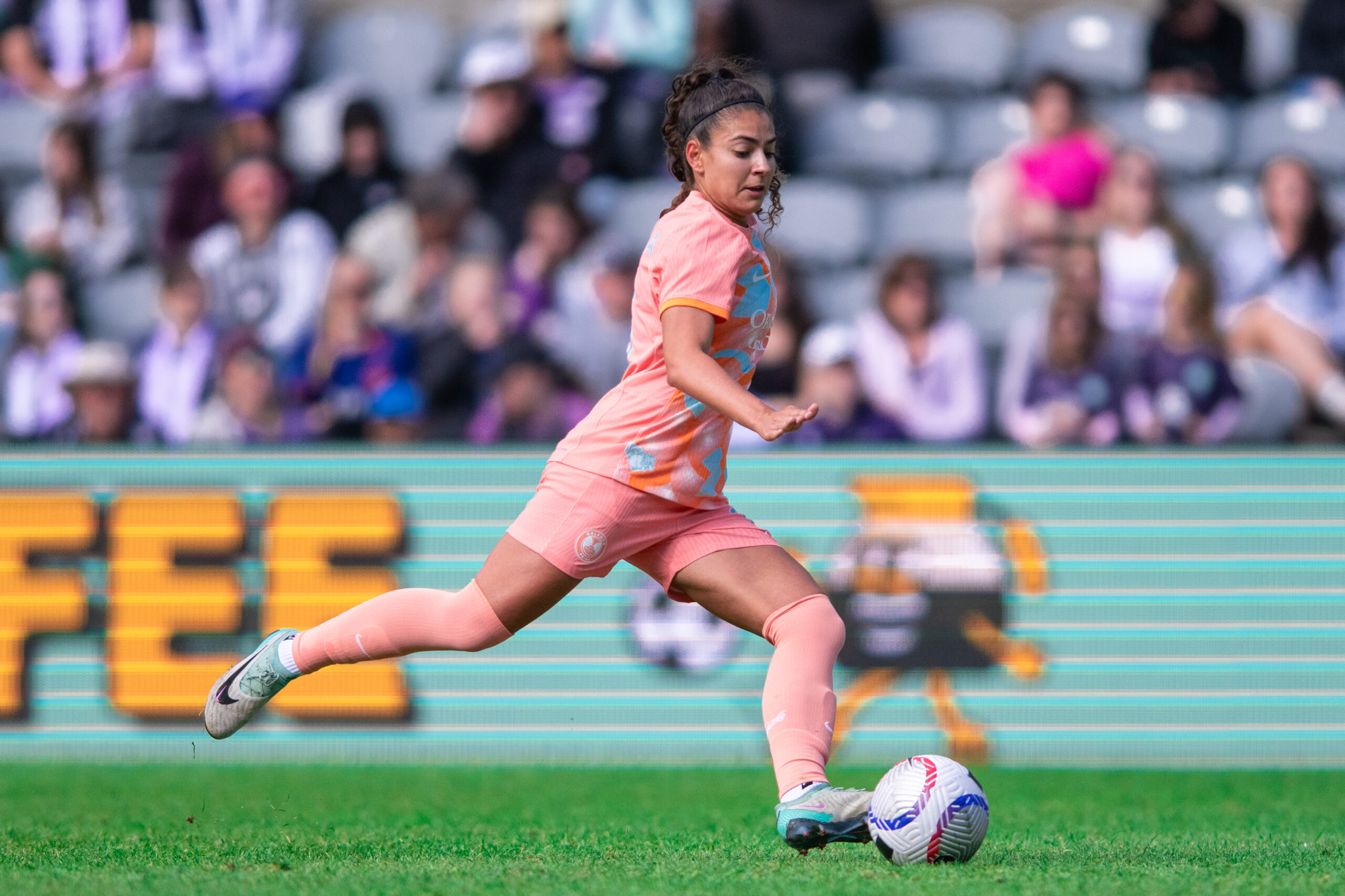
The Pride are riding a three-match winning streak heading into Friday’s match against Racing Louisville — the team’s final game before the NWSL’s summer break. Given this is the last match until August, it is important that the Pride make a statement and leave an impression on the competition. What do the Pride need to do to take all three points from Racing Louisville at Lynn Family Stadium Friday night?
More Offense
The Orlando Pride have scored six goals in the last six matches. That might not seem too bad, but three of those goals came on Barbra Banda’s hat trick against the Utah Royals. That means in the other five matches, the Pride have only scored three goals. That isn’t enough for a team that wants to repeat the double.
I don’t think the team has found a proper replacement for the departed Adriana. Seb Hines has tried using Ally Watt, Prisca Chilufya, and Julie Doyle, though none have contributed to a commensurate level. Without another threat up top, teams can focus more heavily on Banda, making it difficult for her to score. Hines needs someone to step it up a notch by being a legitimate scoring threat, thus freeing Banda to deal with only two defenders and not three or four. This is the last chance before the break to figure it out.
Stop Sears and Co.
The Pride will face a capable Racing Louisville offense. Emma Sears leads the way for Louisville with six goals this season. The opposition also has Savannah DeMelo, Taylor Flint (née Kornieck), and Kayla Fischer. Louisville has 17 goals this season compared to the 20 scored by Orlando. I’m saying that Louisville is a legitimate threat.
I feel that Hines found the best back line in the last match with Oihane at right back, Emily Sams and Kylie Nadaner at center back, and Cori Dyke on the left. This is the back four that I think will provide the best defense in front of Anna Moorhouse. That is the back line that will need to deal with Sears and the others. A clean sheet may be a lot to ask on the road, but this defense could make it happen.
Back to Basics
The last few matches the Pride have taken short corners at almost every opportunity presented. Please stop doing that. No more Pepper Shakers or Loki’s Toboggan — see Ted Lasso season 1, episode 10. Put the ball in the box and let things happen. Between Marta, Angelina, Carson Pickett, and Summer Yates, the Pride have enough players who can put in a good ball from a corner kick or free kick.
Weird and sometimes wonderful things happen when you simply put the ball in the box. A player can score a header, the ball can bounce to a player for a shot, there could be an own goal, or even a handball resulting in a penalty. Yes, the ball might go out for a goal kick or a Pride player could commit a foul, but the team’s success rate on short corners is not good and Orlando has capable scorers who can finish in close. Leave the tricksy training ground antics at home and put the ball in the darn box.
That’s what I’ll be looking for Friday night. Where do you think the game will be won or lost? Let us know in the comments section.
-
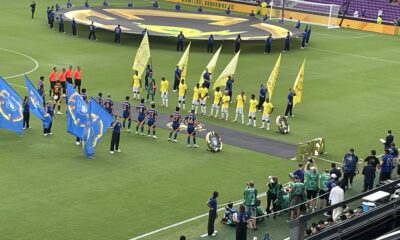
 Local Soccer Events3 days ago
Local Soccer Events3 days agoUlsan HD FC vs. Mamelodi Sundowns FC: Final Score 1-0 as South African Side Wins First FIFA Club World Cup Match in Orlando
-
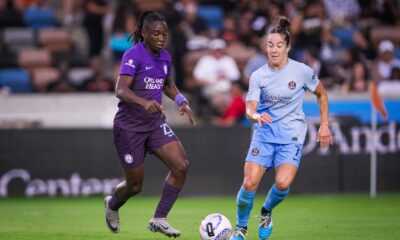
 Orlando Pride2 weeks ago
Orlando Pride2 weeks agoOrlando Pride vs. Houston Dash: Preview, How to Watch, TV Info, Live Stream, Lineups, Match Thread, and More
-

 Orlando Pride1 week ago
Orlando Pride1 week agoOrlando Pride vs. Bay FC: Preview, How to Watch, TV Info, Live Stream, Lineups, Match Thread, and More
-
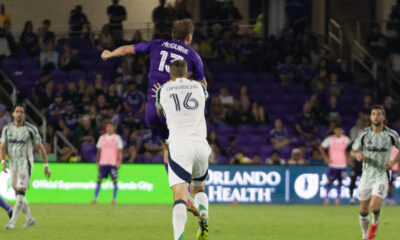
 Orlando City2 weeks ago
Orlando City2 weeks agoOrlando City Striker Duncan McGuire Undergoes Shoulder Surgery
-
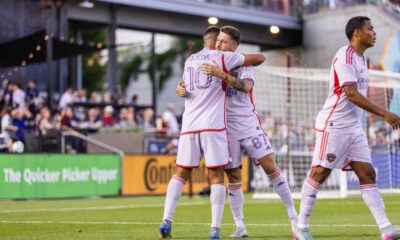
 Orlando City6 days ago
Orlando City6 days agoOrlando City vs. Colorado Rapids: Final Score 1-0 as Ojeda’s Goal Snatches Road Win for Lions
-

 Orlando Pride2 weeks ago
Orlando Pride2 weeks agoOrlando Pride vs. Houston Dash: Final Score 1-0 as Cori Dyke’s Goal at the Death Lifts Pride
-

 Orlando City7 days ago
Orlando City7 days agoOrlando City vs. Colorado Rapids: Preview, How to Watch, TV Info, Live Stream, Lineups, Match Thread, and More
-
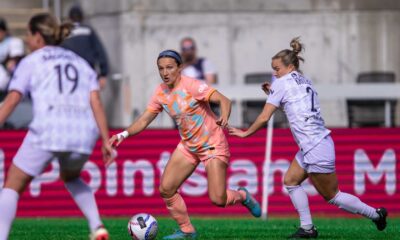
 Orlando Pride13 hours ago
Orlando Pride13 hours agoOrlando Pride vs. Racing Louisville FC: Preview, How to Watch, TV Info, Live Stream, Lineups, Match Thread, and More


